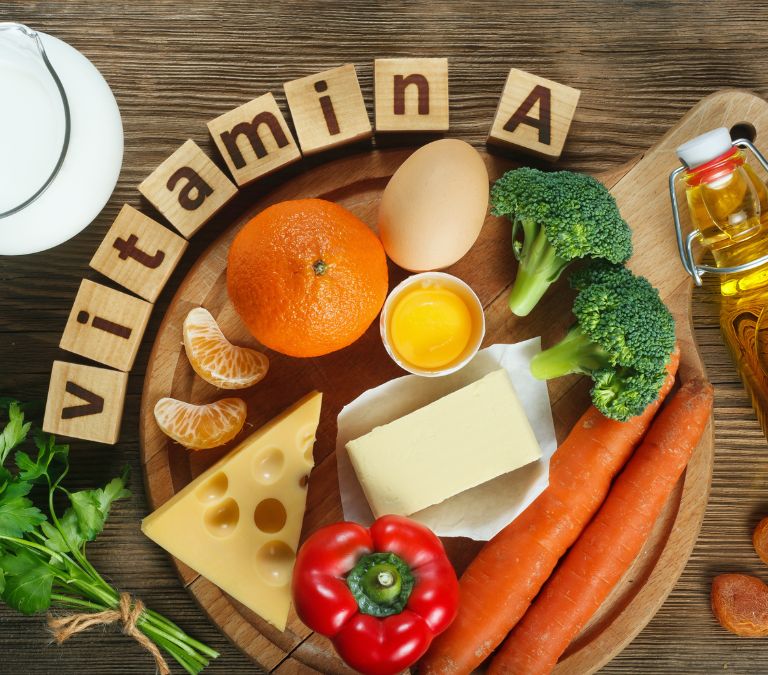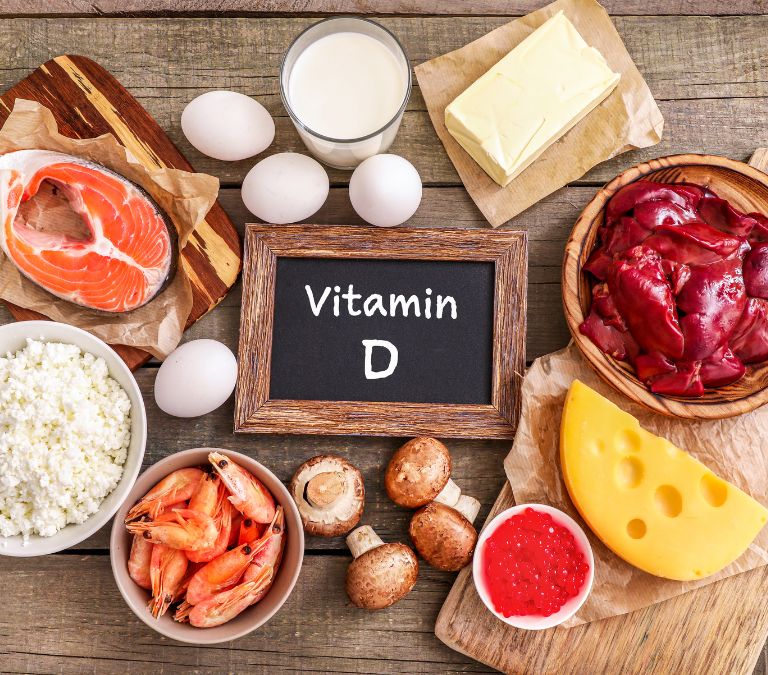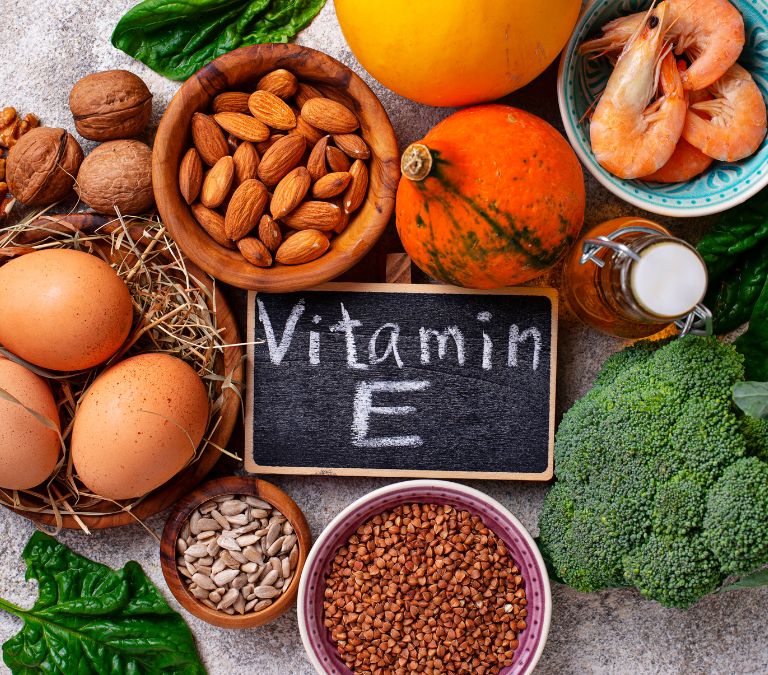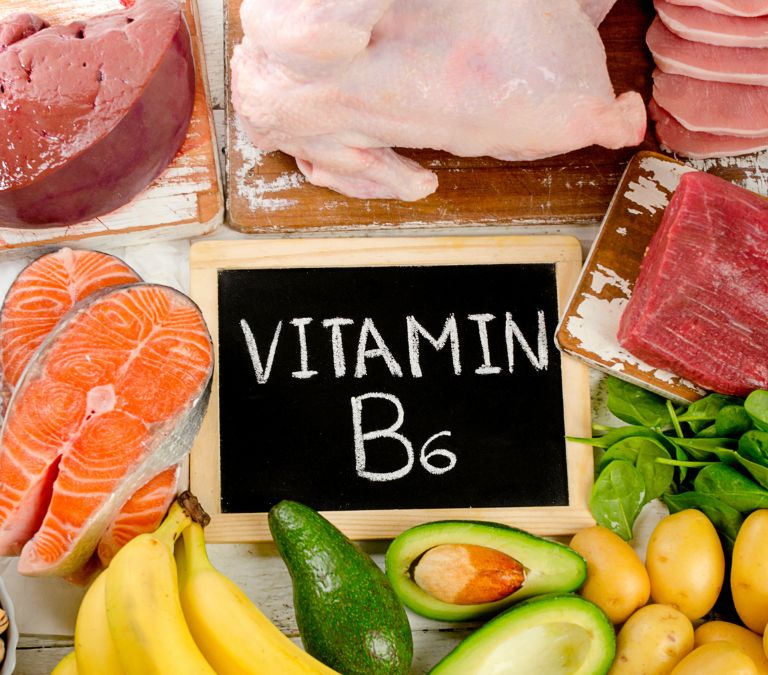Vitamins and minerals are classes of food that are needed in minute quantities for different physiological functions of the body and health maintenance – the reason they are called micronutrients; are they are not synthesized by the body and thus must be obtained from food.
Vitamins and minerals play vital roles in maintaining good health and well-being in menopausal women. Menopause requires daily dietary intake to manage the symptoms accompanying the transition is menopause.
Vitamins and minerals are essential for nerve functioning, muscle toning, and functioning, cell maintenance, and repairs.
Vitamins
Vitamins are organic compounds that contain carbon, hydrogen and oxygen, and other side elements. Vitamins are classified into two (2) groups:–
- Fat-soluble vitamins, and
- Water-soluble vitamins.
Fat-soluble vitamins are organic compounds that can be absorbed only in a fat-laden environment and can be retained in the body; these vitamins have fatty acid chains as side elements and can freely interact with adipose tissues through their fatty acid sides.
Fat-soluble vitamins are transported as fats and are soluble in an organic solvent; they include vitamins A, D, E, and K.
- Vitamin A

Vitamin A, also called retinoid, is of different forms – retinal, retinoic acid, and retinal ester. It is vital for the proper functioning and growth of the body parts – the skin, immune system, and eyes.
Vitamin A is vital in managing night blindness and vision impairment, sagging and aging skin, children’s development, infections, HIV/AIDS, and acne.
Vitamin A can be found in foods like fruits, fish, sweet potatoes, carrots, liver, leafy green vegetables, etc. (in the form of carotenoids usually converted to vitamin A inside the body)
During menopause, the intake of vitamin A helps maintain general health and relieves stress and accompanying inflammation caused by oxidants by acting as an antioxidant; recall that oxidative stress and inflammation are the leading factors to cancers, obesity, diabetes, and some cardiovascular diseases.
- Vitamin D

Occurs in two (2) active forms, vitamin D2 (ergocalciferol) and D3 (cholecalciferol); ergosterol is mostly gotten from plants sterol, ergosterol when they are irradiated by the ultraviolet rays of the sun and the cholecalciferol, are synthesized from the skin after the action of UV rays of the sun on dehydrocholesterol on human skin – the body still utilizes these 2 active forms.
Vitamin D is vital in promoting phosphorus and calcium absorption from the gut and influencing bone mineralization. It is also important in absorbing phosphorus and magnesium; and managing inflammation, cancers, and infections.
Although the human body naturally synthesizes vitamin D, humans can still get vitamin D foods like fish and liver oils, fatty fish, yolks of eggs, cheese, certain edible mushrooms, fortified plant milk, beef liver, sardines, and fortified cereals.
Vitamin D is good in menopausal women as it helps manage various accompanying symptoms like obesity, osteoporosis, osteomalacia (bone softening in adults), and inflammation due to oxidative stress that usually leads to type II diabetes, cancers, and heart diseases.
- Vitamin E

Vitamin E, a fat-soluble vitamin also known as tocopherol, is an essential antioxidant that is active in mopping and inhibiting the further release of free radicals by protecting polyunsaturated fatty acid chains from oxidative degradation; enhancing immune functions, and protecting the arteries and other blood vessels from clog and plaque formation and deposition.
Vitamin E has four (4) forms – alpha tocopherols, beta tocopherols, gamma tocopherols, and alpha tocotrienols (from plant sources); but the most active form that is readily absorbed by the human body is the alpha tocopherols.
Vitamin E is largely found in plant-based foods like seeds, nuts, whole grains, vegetable oils, avocado, leafy green and cruciferous vegetables, and wheat germ.
Vitamin E plays a key role in easing and managing some menopausal symptoms relating to eyes (retinopathy or eye cells degradation usually caused by aging and diabetic disease condition), stroke (due to nerve damage (peripheral neuropathy and ataxia), and other symptoms caused by oxidative stress like cancers (due uncontrolled cell death as a result of compromised cell compositions from free radicals), diabetes mellitus, etc.
- Vitamin K
Occurs in two (2) active forms in the human body – vitamin K1 known as phylloquinone (sourced from plants and other food classes) and vitamin K2 known as menaquinones (sourced from bacteria (microflora in the guts of humans) and synthetically in the laboratory).
The human liver utilizes vitamin K to form blood clotting factors and proteins like fibrin, thrombin, and prothrombin to help manage bleeding and blood clots. It is also involved in bone-building by facilitating calcium uptake, or bone mineralization, by producing a protein known as osteocalcin.
Vitamin is abundant in green and cruciferous vegetables like kale, collard green, spinach, broccoli, cabbage, lettuce, etc., yogurt, cheese, soy and soy oil, shakes, salad dressings, fruits, and other fortified foods.
Vitamin K helps manage metabolic syndrome, osteoporosis, bleeding, and blood clotting-associated problems in menopausal women.
- Water-soluble Vitamins
…include vitamin C and the B vitamins – thiamin, niacin, pantothenic acid, and riboflavin. They are called water-soluble because they can only be absorbed in a hydrophilic environment and thus are not retained or stored in the body like their sister fat-soluble vitamins. Their excesses are usually removed from the body through urines and feces. Below are the properties and functions of the water-soluble vitamins:-
- Vitamin C

Also known as ascorbic acid plays a vital role in wound healing processes and infection control due to its antioxidant properties through inhibiting the release of free radicals during oxidative stress and degradation of already released oxidative ions.
It is a key substance in the production of collagen – a skin and muscular protein abundant in connective tissues involved in the coordination of various important systems vital for survival in humans like the immune system (white blood cells production and stimulation), bone formation, cartilage formation, blood production and functions, and clotting; and in production of key hormones and neurotransmitters for various body coordination through the brain and spinal cord; even the peripherals.
Vitamin C is abundant in vegetables and fruits, especially citrus fruits – bell peppers, oranges, lemon, kiwi, grapefruit, tangerine, tomatoes, cabbage, broccoli, Brussels, cauliflower, strawberries, and white potatoes, to mention but a few; vitamin C is available as a supplement too.
Vitamin C plays an important role in the management and easing of menopausal symptoms as it is very effective in managing cognitive problems and depression resulting from hormonal imbalance, cardiovascular diseases, and diabetes mellitus due to oxidative stress, metabolic syndrome, sagging and loosening of the skin, loss of teeth due to gum bleeding and vision defect from aging cells.
- B Vitamins
The B vitamins include vitamin B-1 (thiamine), B-2 (riboflavin), B-3 (niacin) B-5 (Pantothenic acid) B-6 (pyridoxine), B-9 (folate), and B-12 (cobalamin).
- Vitamin B-1 (Thiamine)
Thiamine is a cofactor for most enzymes involved in the breakdown of glucose; its deficiency results in the depletion of adenosine triphosphate (ATP), often leading to dysfunction of nerves, tissues of vital organs like the brain, spinal cord, heart, and skeletal muscles resulting in heart failure, fluid retention (edema) and dyspnea, memory loss, ataxia, confusion, etc.
Thiamine sources are fatty fish like salmon and tuna, nuts, eggs, lentils, green peas, brown rice, whole meal, lean beef, yogurt, etc.
Thiamine intake by menopausal women is helpful in the management of anxiety and mood swing symptoms, general metabolic processes, and nerve function improvement.
- Vitamin B-2 (Riboflavin)
Riboflavin is a cofactor of different reduction-oxidation reactions involving flavin adenine dinucleotide (FAD) and flavin mononucleotide (FMN). It plays a great role in fighting tissue and cell inflammation in the eyes and bones. It is highly sensitive to ultraviolet (UV) light and thus is always stored in opaque containers.
Foods rich in riboflavin are lean meats, milk, eggs, meat organs- kidney, liver, gizzards and hearts, whole grains, veggies, and fortified cereals.
Riboflavin has been said to be involved in the synthesis of estrogen, the main hormone whose production ceases during menopause and thus causes a range of symptoms for which menopause is characterized; therefore, riboflavin can soothe almost all menopausal symptoms once estrogen production has been guaranteed with riboflavin.
- Vitamin B-3 (Niacin)
Niacin is a B-vitamin derived from tryptophan and is involved in the reduction-oxidation reaction in pathways involving nicotinamide dinucleotide (NAD+) and nicotinamide dinucleotide phosphate (NADP+).
Niacin is key in managing dyslipidemia, diarrhea, dementia, facial flushing, and dermatitis.
The foods rich in niacin are avocado, tuna, liver, lentils, salmon, potatoes, bananas, broccoli, whole grains, brown rice, etc.
A form of vitamin B-3 called niacinamide is very helpful in managing flushing and hot flashes – a typical menopausal symptom.
Although other forms of niacin help manage blood vessel clogging and blockage, they are not good if their use is to relieve hot flashes and flushing as they rather aggravate the symptoms rather than reduce them.
- Vitamin B-5 (Pantothenic acid)
Pantothenic acid is an important cofactor in the pathways involving coenzyme A and in the synthesis of fatty acids by co-factoring with the enzyme called fatty acid synthase. Coenzyme A and fatty acid synthase enzymes are crucial in energy production pathways and the synthesis of hormones.
Pantothenic acid plays an important role in treating and managing enteritis, adrenal insufficiency, alopecia, and dermatitis and in producing steroids like testosterone, cortisol, and estrogen. It is also important in reducing low-grade inflammation.
The following are sources of pantothenic acids – mushrooms, avocado, nuts, seeds, beef, organ meat –liver, kidney, heart, intestines,
According to a recent report, the antioxidant property of pantothenic acid, through its action against low-grade inflammation, makes it vital in managing heart diseases – a harmful symptom of menopause.
- Vitamin B-6 (Pyridoxine)
Pyridoxine is a B-vitamin involved in many biological processes like phosphorylation, decarboxylation, and transamination; it is vital in red blood cell formation and brain signaling.
Pyridoxine is key in treating and managing mental confusion, peripheral neuropathy, anemia, convulsion, and hyperirritability.
Pyridoxine is abundant in the following foods and fruits – bananas, liver, salmon, chickpea, sunflower seed and oil, oats, asparagus, carrots, tofu, etc.
The intake of pyridoxine from both supplement and dietary sources by women undergoing menopause transition helps in the mood swing, anxiety, and depression as pyridoxine is key in the production of serotonin – a chemical that helps in relaxing the brain cells and improving mental functions and cognitive ability and invariably managing insomnia too and hot flashes and flushing.
- Vitamin B-9 (Folate)
Folic Acid (Folate – basic form) is a vital B-vitamin involved in deoxyribonucleic acid (DNA) and ribonucleic acid (RNA) biosynthesis. It manages megaloblastic anemia, neural tube defects, and macrocytic anemia.
Sources of folate (folic acid) are beetroot, pawpaw, black-eyed peas, lentils, avocado, leafy green veggies, cruciferous veggies, nuts, eggs, liver, etc.
Research shows that folate can reduce the severity and duration of hot flashes during menopause. Folate also regulates estrogen production and gene effects.
- Vitamin B-12 (cobalamin)
Cobalamin Vitamin B12 plays a key role in the development and functioning of brain and nerve cells; and red blood cell production (erythropoiesis) in the bone marrow of humans.
Cobalamin is helpful in the management of pernicious anemia and macrocytic and megaloblastic anemia.
The following are dietary sources of cobalamin – shellfish, cheese, yogurt, milk, lean red meat, eggs, liver, fish, sardines, etc.
Cobalamin is essential in managing menopausal symptoms like metabolic syndrome, nerve functions, cardiovascular dysfunction, osteoporosis, insomnia, retinopathy, anxiety and depression, and cognitive and general brain function.
Minerals
Minerals are another set of micronutrients of great importance and function alongside vitamins to bring about many biological processes – synthesis, conversation, degradation, up-regulation, down-regulation, absorption, re-absorption…you name them.
Minerals are of two (2) groups:-
- Macro-minerals
- Trace minerals
Macro-minerals are termed so because they are needed in large quantities by the body in maintaining biological processes like enzyme synthesis and activation; and hormone synthesis, activation, and inactivation; deficiencies in any of these mineral sets will pose a serious threat to life, especially in children, aging adults and women undergoing menopause transition.
Macro-minerals include – magnesium, potassium, sodium, chloride, calcium, and phosphorus.
Trace minerals are minerals needed by the body in minute quantities; their absence does not pose any visible danger, but their presence does a lot of fine-tuning in the biological processes they are involved in.
The trace minerals include – iron, cobalt, zinc, manganese, copper, fluoride, etc.
Minerals are of great essence in the management and easing of menopausal symptoms as most biological processes halted by the lowered estrogen level for which menopause is characterized usually reactivated by the presence of minerals and vitamins; and having discussed vitamins above, below are different minerals and the respective importance in different biological processes and in managing menopausal symptoms:-
- Magnesium
Magnesium is a micro-mineral notable for being a cofactor to over 300 enzymes involved in different biological pathways; it acts as an electrical conductor in muscular contractions and relaxations and the maintenance of the circadian rhythm, nerve functions, and bone density.
Magnesium is well excreted by the kidneys through urine and thus does not become excess in the body even during supplementation.
Magnesium sources include – almonds, nuts, whole grains, seeds, beef, poultry foods, leafy green veggies, legumes, fortified food, fish, brown rice, oatmeal, soymilk, banana, etc.
Magnesium plays a critical role in the easing and management of menopausal symptoms like osteoporosis, insomnia, cardiovascular dysfunction, and anxiety disorders,
- Potassium
Potassium is a macro-mineral referred to as an electrolyte due to its ionic form in the body and its subsequent involvement in different cellular and nervous functions; it is an important mineral when it comes to electrolyte and fluid balance in the body; and also key to muscular contractions and normalizing blood pressure.
Potassium is excreted through urine, stool, and sweat and therefore is hardly excess (unless in people with compromised kidney functions), although it can be deficient.
The food sources of potassium include – lentils, beans, butternut, spinach, beet greens, oranges, avocado, tomatoes, almond milk, soymilk, cashew nut, almond nuts, salmon, bananas, etc.
Potassium is helpful in the management of menopausal symptoms like metabolic syndrome, diastolic and systolic pressure, stroke, and atherosclerosis,
- Sodium
Sodium works together with potassium in the balancing of fluid and electrolyte as well as blood pressure balancing though in a reverse effect, that is, as potassium works to lower blood pressure, sodium tends to increase it as such, an equilibrium (balance) is maintained for all the biological processes they are both involved in.
Sodium is important in maintaining nerve impulses, muscular contractions, and relaxations, fluid and electrolyte balance.
As much as the kidneys (healthy) function through the effects of the action of a chemical messenger called aldosterone to maintain sodium balance (osmolality), it is still key to balance sodium intake as too much sodium concentration in the bloodstream has an immediate deleterious effect.
Common salt or table salt, as the case may be, is the primary dietary source of sodium; other sources are chicken, meats, shellfish, seafood, and vegetables.
Sodium, unlike other minerals, has adverse effects on menopausal symptoms; that is, they aggravate the symptoms like hypertension, cognitive functions, general brain coordinative ability, etc., and thus sodium intake and balance should be kept a tab on so always through a regular check, especially in women undergoing menopausal transition.
- Chloride
Chloride is also obtained from table salt, just like sodium, and it works closely with sodium in many biological processes it is involved in.
- Calcium
Is a macro-mineral closely associated with healthy bone formation and functioning; it is also a key mineral in blood clotting, muscular and nerve functioning, and the regulation of heartbeats.
The bone is the storehouse of calcium in the human body, and thus calcium is always accumulated in or released from the bones or lowering the concentration of blood calcium as the case may be from the action of parathyroid and calcitonin hormones.
Calcium deficiency results in soft bones and weak teeth, while excess calcium results in frequent fracturing due to too much bone briskness.
Dietary sources of calcium include – lean meat, milk, meat bones, cheese, butternut squash, soybeans, almond, brown rice, salmons, bone meals, green veggies, etc.
Calcium, when taken in the required quantity, is helpful in the management and easing of osteoporosis and bone density depreciation, muscular dystrophy, and heart diseases which are notable menopausal symptoms. But when in excesses from supplementation, calcium could become an aggravating factor to the symptoms of menopause like heart diseases and bone fractures.
- Phosphorus
Phosphorus is an important component of the cell membrane, teeth, and bones. Thus, it is essential to maintain healthy teeth and bone formation and functioning, most exclusively cellular function, membrane formation, and protection. It is also crucial in activating different enzymes involved in many biological processes and maintaining blood pH balance.
Hydrogen is a key component of nucleic acids (DNA and RNA) and energy carrier molecules like ATP, NADPH, and FADPH and invariably play key roles in gene formation and expression.
Phosphorous is regulated by important organs like the intestines, kidneys, and bones.
The dietary sources of phosphorous include – red meat, seafood, legumes, whole grains, seeds, nuts, chicken, etc.
The dietary intake of phosphorus is helpful, according to research in the management of menopausal symptoms like cell deaths and functions usually due to compromised cell walls, often resulting in diabetes, cardiovascular diseases, and cancers.
- Iron
Iron is a trace mineral essential for red blood cell formation and functions. It is helpful in managing anemic conditions; it is a key property in the function of the red blood cells as oxygen and carbon dioxide transporter.
Iron can be found in dietary sources such as red meat, poultry, legumes, seafood, nuts, green leafy vegetables, whole grains, etc.
Iron is great in managing shortness of breath, inflammation due to oxidative stress, metabolic syndrome, anxiety and confusion, and heartbeats as symptoms of menopause.
Other trace minerals like zinc, fluoride, manganese, copper, and cobalt are essential in the activation of different enzymes catalyzing many biological processes. They are major players in cell growth, development and differentiation, healing processes, and immune activation and functions.
Their sources are most staple foods, especially those in the dietary recommendation for the major minerals and vitamins.
In conclusion, vitamins and minerals are key nutrients required in everyday life, especially in women undergoing a menopausal transition, as they play crucial roles in different biological processes required for healthy body maintenance.
There is a piece of accompanying good news: most of the required vitamins and minerals can be obtained from cheap and natural sources like fruits, green leafy and colored veggies, dairy products, whole grains, and so on.







